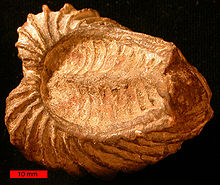
Gryphaea, common name devil's toenails, is a genus of extinct oysters, marine bivalve mollusks in the family Gryphaeidae.

Spondylus is a genus of bivalve molluscs, the only genus in the family Spondylidae. They are known in English as spiny oysters.

Venus is a genus of small to large saltwater clams in the family Veneridae, which is sometimes known as the Venus clams and their relatives. These are marine bivalve molluscs.

Palaeoheterodonta is a subclass of bivalve molluscs. It contains the extant orders Unionida and Trigoniida. They are distinguished by having the two halves of the shell be of equal size and shape, but by having the hinge teeth be in a single row, rather than separated into two groups, as they are in the clams and cockles.

Trigonioidea is superfamily of medium-sized saltwater clams, marine bivalve molluscs. Within the fossil record the occurrence of this superfamily is widespread, ranging from the Devonian Period to Recent.

The Gryphaeidae, common name the foam oysters or honeycomb oysters, are a family of marine bivalve mollusks, and are a kind of true oyster. This family of bivalves is very well represented in the fossil record, however the number of living species is very few.

Pinna is a genus of bivalve molluscs belonging to the family Pinnidae. The type species of the genus is Pinna rudis.

Atrina is a cosmopolitan genus of bivalve molluscs belonging to the family Pinnidae.
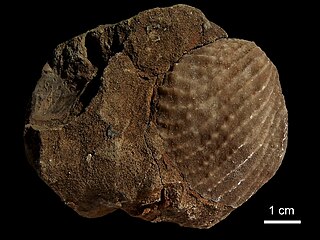
Myophorella is a genus of fossil saltwater clams, marine bivalve mollusks in the family Trigoniidae. These bivalves are sometimes preserved with mineralized soft tissue.
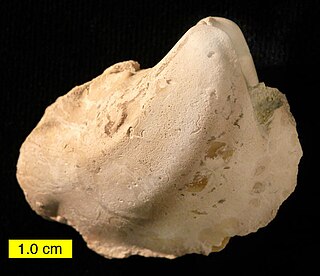
Laevitrigonia is a genus of fossil clams, marine bivalve mollusks in the family Trigoniidae. This bivalve is sometimes preserved with mineralized soft-tissue.
Hemiconcavodonta is an extinct genus of bivalve in the extinct family Praenuculidae. The genus is one of three genera in the subfamily Concavodontinae. Hemiconcavodonta is known solely from late Ordovician, Caradoc epoch, fossils found in South America. The genus currently contains a single accepted species, Hemiconcavodonta minuta.
Concavodontinae is an extinct subfamily of prehistoric bivalves in the family Praenuculidae. Concavodontinae species lived from the middle Ordovician, Caradoc epoch through the late Ordovician Ashgill epoch. Concavodontinae fossils are found in Europe and South America, and species are thought to have been stationary attached to substrate in shallow infaunal marine water environments where they formed shells of an aragonite composition. The subfamily Concavodontinae was named by Teresa M. Sánchez in 1999.
Cuyopsis is an extinct genus of bivalve in the extinct family Praenuculidae. The genus is one of eleven genera in the subfamily Praenuculinae. It is one of three Praenuculinae genera known solely from late Ordivician, Caradoc epoch, fossils found in South America. Cuyopsis currently contains a single accepted species, Cuyopsis symmetricus.
Villicumia is an extinct genus of bivalve in the extinct family Praenuculidae. The genus is one of eleven genera in the subfamily Praenuculinae. It is one of three Praenuculinae genera known solely from late Ordovician, Caradoc epoch, fossils found in South America. Villicumia currently contains a single accepted species, Villicumia canteraensis.

Trigoniida is an order of medium-sized saltwater clams, marine bivalve molluscs. Within the fossil record the occurrence of this order is widespread, ranging from the Devonian Period to Recent.
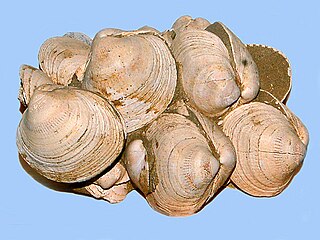
Glycymeris, common name the bittersweet clams, is a genus of saltwater clams, marine bivalve molluscs in the family Glycymerididae.

Pholadomya is a genus of saltwater clams, marine bivalve molluscs in the family Pholadomyidae.
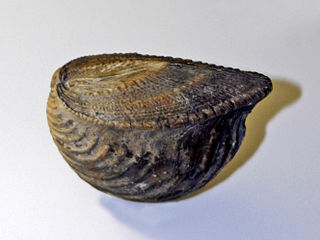
Trigonia is an extinct genus of saltwater clams, fossil marine bivalve mollusk in the family Trigoniidae. The fossil range of the genus spans the Paleozoic, Mesozoic and Paleocene of the Cenozoic, from 298 to 56 Ma.

Neotrigonia is a genus of living saltwater clams, marine bivalve mollusks in the family Trigoniidae, which otherwise consists only of fossil genera. For a long time the entire family was thought to be long extinct, but a living species that is now placed in this genus was discovered in 1802. At that time it was assigned to the fossil genus Trigonia. Currently, according to the World Register of Marine Species, 8 species in this genus are recognized.

Neotrigonia margaritacea, common name the pearly brooch-shell, is a species of saltwater clam, a marine bivalve mollusc in the family Trigoniidae. This species is known from sandy substrates in shallow seas in southeastern and southwestern Australia. This species was the first member of the family to be discovered alive; previous to its discovery, trigoniids were only known from fossils.
